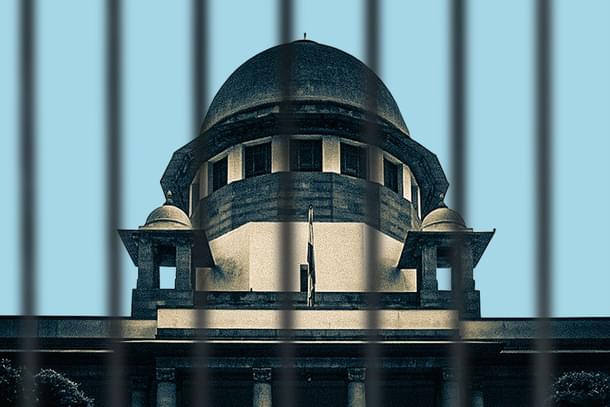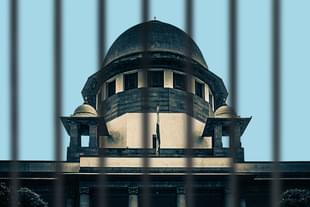Ideas
Is It Time To ‘Lockdown’ The PIL Industry?
Abhishek Gupta
May 06, 2020, 11:55 AM | Updated 12:59 PM IST
Save & read from anywhere!
Bookmark stories for easy access on any device or the Swarajya app.


PIL (Public Interest Litigation) petitions in India date back to the late 1970s and early 1980s, alias the golden age of Indian jurisprudence.
Eminent and scholarly judges like Justice V.R. Krishna Iyer and Justice P.N. Bhagwati were the original pioneers of PIL who fine-tuned this branch of law with their numerous judgments.
The phenomenon of PILs was inaugurated by Justice Krishna Iyer in Mumbai Kamgar Sabha vs. Abdulbhai case, sans baptising it, but by espousing test litigations, representative action, pro-bono public and ventilation of collective or common grievances.
The expression was used for the first time in Fertilizer Corporation Kamgar Union vs. Union of India, wherein Justice Krishna Iyer called PIL a ‘part of the process of participative justice’ and ‘standing’ in civil litigation of that pattern must have liberal reception at the judicial doorstep.
Any doubts and reservations about the nascent concept of PIL were finally laid to rest by the Supreme Court in S.P. Gupta vs. Union of India, where Justice Bhagwati stamped the final approval on the validity of PILs and impressed upon the need to liberalise the ‘Rule of locus standi’ in order to effectively police the corridors of power and prevent violations of law.
However, interference by a busybody or meddlesome interloper under the guise of a public interest litigant was also augured by Justice Bhagwati.
If one looks at the nature of petitions that were filed in the court, primarily the Supreme Court, the overarching intent and purpose of such petitions was to alleviate the misery and suffering of the downtrodden, disabled and marginalised sections of the society — people who are so placed in life that they are not able to approach the court on their own on account of their dire social and economic station.
In this regard, one can easily recall the cases that were brought on behalf of the under-trial prisoners who were blinded in Bihar, cleaning up of river Ganga, prison reforms, bonded labour, displaced tribals and the like.
The people who moved the court were genuinely interested in human welfare and their objective was totally altruistic and admirable.
In Bandhua Mukti Morcha and S.P. Gupta, the Hon’ble Supreme Court also laid down the broad parameters to govern the substantive and procedural rules of PILs.
Any deliberation on PILs in India is incomplete without reproducing the following extract from Bandhua Mokti Morcha, where Justice Bhagwati in his inimitable style observes:
We are so much accustomed to the concepts of Anglo-Saxon jurisprudence which require every legal proceeding including a proceeding for a high prerogative writ to be cast in a rigid or definitive mould and insist on observance of certain well-settled rules of procedure, that we implicitly assume that the same sophisticated procedural Rules must also govern a proceeding under Article 32 and the Supreme Court cannot permit itself to be freed from the shackles of these Rules even if that be necessary for enforcement of a fundamental right. It is clear on the plain language of clause (1) of Article 32 that whenever there is a violation of a fundamental right, anyone can move the Supreme Court for enforcement of such fundamental right. Of course, the court would not, in exercise of its discretion, intervene at the instance of a meddlesome interloper or busybody and would ordinarily insist that only a person whose fundamental right is violated should be allowed to activise the court, but there is no fetter upon the power of the court to entertain a proceeding initiated by any person other than the one whose fundamental right is violated.
The PIL in the early years contributed a great deal to the development of law and jurisprudence in India and set a new direction in various fields.
Eradication of corruption, police reforms, labour rehabilitation, women’s rights, sexual harassment, environmental protection, health and education rights got a huge fillip owing to PIL petitions.
However, over the years, vested interests saw a bright future and opportunity to join the PIL industry.
Some saw it as a shortcut to instant fame and recognition in the profession; others to make a quick buck.
There was yet another section which was endeavouring to embarrass the duly elected governments by virtue of bogus PIL petitions.
These are/were people who were donning two hats, or maybe, three: professional lawyer, human rights activist and as an active or an aspiring politician.
Let me hasten to add that I am not questioning the ability, competence and the legal scholarship of some of the PIL petitioners; not all can be tarred with the same brush. Some of them have in the past rendered yeoman service to the legal system, but unfortunately, political expediency and motivation appears to have overtaken original intent.
The Supreme Court, in the developing stage of PILs, was fully conscious of the tendency to commercialise and politicise PILs, and in S.P. Gupta, cautioned:
...we must hasten to make it clear that the individual who moves the court for judicial redress in cases of this kind must be acting bona fide with a view to vindicating the cause of justice and if he is acting for personal gain or private profit or out of political motivation...the court should not allow itself to be activized at the instance of such person and must reject his application at the threshold, whether it be in the form of a letter addressed to the court or even in the form of a regular writ petition filed in court.
Since then, the apex court, on several occasions, has lamented the misuse of PILs and admonished the unscrupulous and mischievous litigants who abuse the PIL process for personal gain, private motive, political motivation or other oblique consideration.
In Ashok Kumar Pandey vs. State of W.B., Justice Arijit Pasayat came down heavily on a petitioner who had challenged the conviction and pending death sentence of a third party in a PIL, and observed:
Public interest litigation which has now come to occupy an important field in the administration of law should not be ‘publicity interest litigation’ or ‘private interest litigation’ or ‘politics interest litigation’ or the latest trend “paise income litigation”. If not properly regulated and abuse averted it also becomes a tool in unscrupulous hands to release vendetta and wreak vengeance as well. There must be real and genuine public interest involved in the litigation and not merely an adventure of a knight errant or poke one’s nose into for a probe.
In State of Uttaranchal vs. Balwant Singh Chaufal, the Supreme Court had issued a slew of directions to preserve the purity and sanctity of the PIL such as prior verification of the credentials of the petitioner, prima facie satisfaction regarding the correctness of the contents of the petition and public interest, levy of exemplary costs and similar methods to curb petitions filed for extraneous considerations etc.
This decision also led to the formulation of PIL guidelines by the different high courts.
While the guidelines exist for entertaining the PILs in the Supreme Court and the High Courts, however, they have been unable to nip the vexatious and frivolous litigations in the bud.
The words ‘other matters of public importance’ under the Supreme Court guidelines on PIL leave a lot of fairplay in the joints.
These guidelines require a relook now and reflect the dynamism that has become synonymous with the apex court in recent years.
In normal times, the filing of PILs and engaging the attention of the courts is quite penetrable, and even, laudable.
It is also understandable that all such petitions may not be raising legitimate concerns, and if, in such process, precious time of the court is wasted, perhaps, the same can be overlooked.
However, what concerns me the most, as a citizen and a lawyer, is the spate of such petitions in the last few years, in general, and after the outbreak of pandemic, in particular.
I enlist below some of the motivated and misconceived PIL petitions seeking reliefs which are ex-facie non-justiciable and purely pertain to the matter of executive policy.
A PIL filed in the Supreme Court questioning the PM Cares Fund and various CM Relief Funds specially set up to deal with the COVID-19 crisis was dismissed by the court with a stringent caveat to the petitioner to either withdraw the petition or face costs.
Some other PILs seeking outrageous directions such as immediate relaxation of medical expenses related to non-COVID-19 ailments, nationalisation of the healthcare sector and related services, collecting samples and testing of all asymptomatic persons in affected cities or district, carrying out universal house-to-house testing to trace people infected by COVID-19, exploring possibilities of alternate Unani and Homeopathic medicines to treat pandemic, loaning at least Rs.10,000 to all the income tax assesses of the country and ilk have met with a similar fate and faced the wrath of the court.
The most incongruous petition that makes a mockery of the highest court is the plea seeking free unlimited calling, data usage and DTH facilities for subscribers, which infuriated the court.
In all such cases, the apex court has notably deferred to the wisdom of the executive and given them the space to function.
It is distressing to see that such PILs are filed particularly claiming same/similar reliefs. However, the spate of PILs continues unhindered, with fresh PILs filed seeking directions to the Chairperson of NEC to prevent any election from taking place anywhere in the country till normalcy prevails, formulation of an appropriate scheme to support advocates from paying their rent, quashing of FIRs registered under Section 188 of the IPC or other petty offences for violation of lockdown etc.
At a time when the Supreme Court is doing its best to keep the ball rolling through virtual courts and video conferencing, it is rather unfortunate that such trumpery proceedings are imposing a mammoth strain on the system laying waste to valuable court time and frustration in the minds of genuine litigants.
It does not require Socratic wisdom to discern that the times the country and the courts confront presently are unprecedented.
It cannot be compared with either the emergency period or any other period in the rich Indian history.
Even so, there is a section in the society obviously inimical to the present political leadership which jumps to file a petition on matters the courts have been loathe to adjudge, and rightly so.
The idea only appears to be to embarrass the government and the courts.
These people are more cognizant of the wisdom of New York Times, the Guardian and CNN, than the national media.
It is distressing to note the absurd prayers in some of such PILs.
It is, in view of these developments, one should seriously and earnestly pose onto oneself the question: Is it the time to lock down the PIL industry?
Let the captains of the PIL industry look for some other avocation. There is no dearth of avenues of doing good work in this country.
Luckily, the people who man the judiciary at the present juncture are made of sterner stuff and don’t give in to emotive, arm-twisting and motivated attacks.
Abhishek Gupta is an independent advocate appearing in various courts, including the Supreme Court of India. He is reachable at abhishek_1509@hotmail.com.





